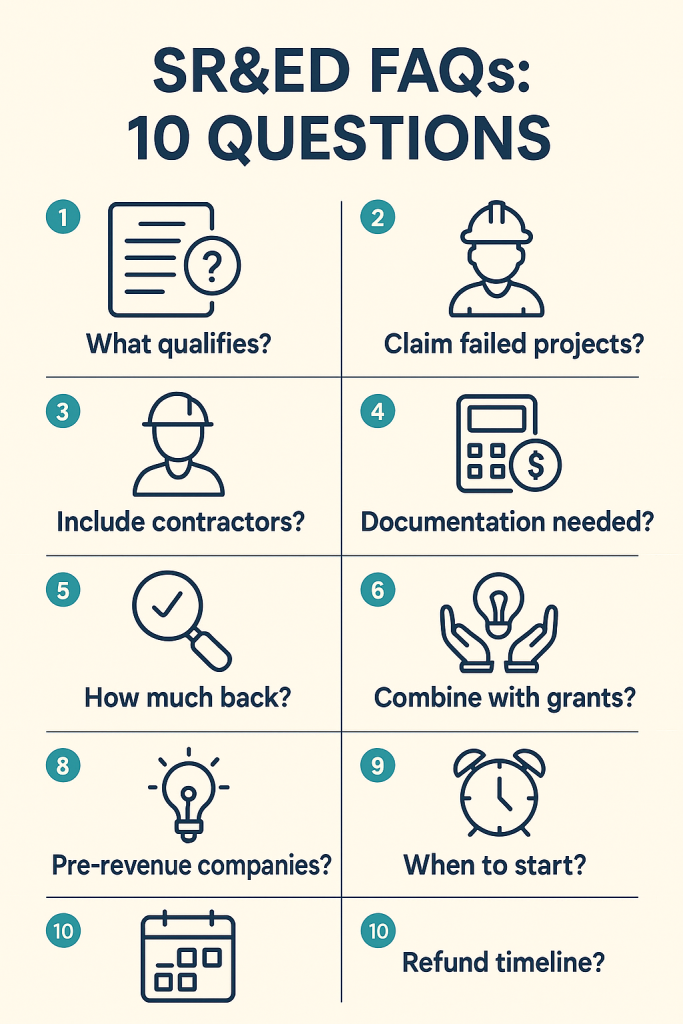SR&ED is one of the most valuable funding programs for Canadian companies doing R&D, but it often feels confusing or overly technical. Whether you are new to it or already claiming, questions always come up.
At RDP, we work with innovative companies across software, clean tech, manufacturing, and life sciences. These are the most common questions we hear, and here is how we answer them.

1. What actually qualifies as SR&ED?
SR&ED is not just about building a product. It also involves solving a scientific or technological problem you did not already know how to solve. That could be a new algorithm, a materials challenge, or a performance issue that requires multiple testing and iterations.
If your team is doing experimental work to resolve uncertainty, you may have an eligible claim.
Read more on eligibility here: SR&ED Claim preparation
2. Can we claim for failed projects?
Yes. In fact, failed projects often make stronger claims. SR&ED is about the attempt to solve a technical problem, not the outcome. If your team tried different approaches and none worked, that is still an eligible SR&ED area in which to make a claim.
What matters is that you had a technological uncertainty to overcome, approached the work systematically, and documented the process.
3. Can we include contractors or consultants?
Yes. However, you can only claim 80% of contractor costs. provided they must also be doing SR&ED-eligible work in Canada, and the contractors themselves are subject to Canadian taxes.
Make sure the work is technical and directly tied to experimentation, not business development or admin, and that the contract reflects this.
Learn more in our Practical Guide to Claiming Contractor Fees for SR&ED
4. What kind of documentation does CRA expect?
CRA periodically reviews SR&ED claims and will request you to provide documentation of the SR&ED work.
Examples of SR&ED documentation include:
i. Design or architecture notes
ii. Technical meeting summaries
iii. Testing logs or prototypes
iv. Timesheets or level-of-effort tracking
If you are already using tools like JIRA, Git, or Notion, that is a great starting point. RDP’s Innovation Connect Program is designed to identify and capture SR&ED work and can be used to improve upon your existing system, where there may be gaps in documentation.
5. What happens if CRA audits my SR&ED claim?
If your claim is reviewed, CRA will request a meeting to ask questions about the SR&ED tax credit claim. This is common and does not mean you did anything wrong.
We support clients through the entire CRA review process, including preparing clients for the CRA review and attending all meetings.
Check out our guide on SR&ED Audit Preparedness for Large Companies
6. How much can we get back?
If you are a Canadian-controlled private corporation that meet certain financial restrictions, you are eligible for a 35% refundable SR&ED credit plusany provincial R&D tax credits. For example, in Ontario the total refundable SR&ED credit is roughly 42% of eligible SR&ED costs.
Non-Canadian Controlled Private Corporations receive a 15% non-refundable federal credit. In addition, they may be eligible for provincial R&D tax credits.
Read our breakdown of SR&ED Expenditure Limits and Potential Changes
7. Can we claim SR&ED and government grants at the same time?
Yes, but any grant received during the year that covers SR&ED expenditures claimed in the year must be netted in calculating the SR&ED credits.
For example, if you received $50,000 from an IRAP grant that covered SR&ED costs and your total SR&ED costs for the year were $100,000, then you deduct $50K from the $100K and claim SR&ED tax credits on the remaining $50K.
We explained this in our post on Combining SR&ED with Government Grants
You can also access a more comprehensive document explaining the differences between SR&ED vs IRAP, and how they work together: SR&ED VS. IRAP
8. Can early-stage or pre-revenue companies claim?
Yes. Many of our clients are startups or pre-revenue. For Canadian Controlled Private Corporations SR&ED tax credits are refundable, which means you can receive cash back even if you are not yet profitable.
This is often a key source of non-dilutive capital in the early stages of growth.
9. When should we start thinking about SR&ED?
Ideally before the work begins. The earlier you plan, the easier it is to track eligible work and prepare the claim.
You must submit your SR&ED claim in your corporate tax return within 18 months of your tax year end.
10. How long does it take to receive the refund?
CRA has service standards to process SR&ED claims. If you are not selected for a CRA review CRA generally processes most claims in 6-8 weeks. If you are selected for review the processing service standard is 6 months.
We work with our clients to ensure timely filing and avoid unnecessary delays.
See our post on How CRA Assesses SR&ED Claims
Final Thoughts
The SR&ED program is still the most generous R&D incentive in Canada. But to get the most out of it, you need to know how to use it properly.
If you are unsure whether your work qualifies or just want a second opinion on your current process, we are happy to take a look. Even small changes can lead to a larger refund or a smoother experience with CRA.
Want to find out what you could be missing?
Get in touch with our team here: Contact Us
